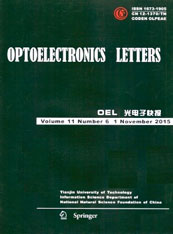
In this paper, a slot microring resonator with a piece of spiral feedback waveguide for CH4 sensing application is pro-posed. This sensor is based on silicon-on-insulator (SOI) substrate and with the operation wavelength in mid-infrared region. To reach high sensitivity and good selectivity, slot cross section and spiral feedback waveguide are carefully tailored. The sensor shows ppb-scale trace gas sensing potential and is easy to be packaged in integrated photonics circuits. Calculation results show that the sensitivity reaches 1.4×10-2 dB/ppm and the detection limit achieves 700 ppb in the case of Lspiral=100Lr.
Based on the principle of Fabry-Perot (F-P) interference, a new type of optical fiber curvature sensor is presented, which is fabricated by single-mode fiber (SMF), ceramic tube and double-cladding fiber (DCF). And the curvature sensing properties are analyzed, and the double-peak method is used to demodulate the cavity length. The experimen-tal results show that the F-P interference spectrum shifts toward long wavelengths with increasing the curvature. And the sensors are placed in different positions on the cantilever to get their different curvature sensitivities. Smaller initial cavity length gives greater sensor sensitivity. The best curvature sensitivity is achieved as 2 554.53 pm/m-1 in 0.71—1.18 m-1. By demodulating the length of the F-P cavity, the cavity length of sensor 4 is changed by 0.08 mm. Therefore, the sensor has some potential for measure the small displacement.
A bandwidth-reconfigurable filter is necessary to meet the need of growing communication capacity and signal cover-age frequency range. The stimulated Brillouin scattering (SBS) gain spectrum as a filter passband is used to extract de-sired microwave signals. Due to the fact that the passband is formed by mapping the Brillouin gain spectrum, band-width reconfigurability can be implemented by changing Brillouin gain linewidth. In this paper, a scheme using a 5-lines optical comb acting as a Brillouin pump is experimentally demonstrated. The spectrum of the 5-lines optical comb is extended by a binary phase shift keying (BPSK) pulse modulated signal. Experiments have shown that the 3-dB and 20-dB bandwidths of the filter are 196 MHz and 257 MHz, respectively, and its 20-dB shape factor is 1.31. The passband ripple is ~3.5 dBm with stop-band rejection of 20 dBm under 15 dBm optical pump power.
There are many problems when traditional temperature sensing radio frequency identification (RFID) tags are applied to logistics temperature monitoring, such as inconvenient data reading, large power consumption, and low bandwidth. Therefore, a low-dissipation electronic tag is designed in this paper to solve the above problems. The electronic tag and the portable temperature recorder were placed in the same position in the same refrigeration unit, and the tem-perature of the same space was recorded at the same time. The data measured by the designed electronic tag was used as the measured value, and the data measured by the portable temperature recorder was used as the standard value. The correlation coefficient between the two was calculated to be 0.866 9, the root mean square error (RMSE) was 0.796 7 ℃, and the average relative deviation (ARD) was 16.21%. Therefore, the electronic tag designed in this study can meet the requirements of users for temperature monitoring and recording. The temperature control switch designed in this study can disconnect the power supply to single chip microcomputer (SCM) and other modules when the tem-perature is in the range of normal threshold, so that the power consumption is further reduced and the cost is reduced. The results of this study laid a foundation for the development of low-cost and easy-to-use temperature monitoring technology in the logistics process.
The existing laser remote range-gated imaging system in China is large, expensive and impractical. To achieve long distance imaging, the high-power laser, high-power laser pulse drive, optical system and field synchronisation control are improved in this paper. The improved system is lightweight, easy to use and has a small volume. Experimental re-sults show that the system can clearly map the target at 6 km far away and has a good adaptive adjustment function.
High-quality KMgF3 single crystal containing 0.5 mol% europium (Eu) was prepared by an improved Bridgman method. X-ray diffraction (XRD), photoluminescence spectra and fluorescence lifetime were measured. The results in-dicate the reduction of Eu3+ to Eu2+ in the KMgF3 single crystal. Under the excitation of 259 nm, 370 nm and 394 nm, the sample has two distinct emissions of Eu2+:4f7→4f7(~363 nm) and 4f65d1→4f7 (~440 nm). The substitution site for Eu ion is confirmed. The optical property investigation result shows that the Eu2+ doped KMgF3 single crystal may be used as potential laser media and related materials for optical devices.
We propose a dispersion flattened fiber (DFF) front-haul transmission system with high bitrate, polarization multi-plexing (PM) and quadrature amplitude modulation (QAM) signal at low input optical power. The modulation format of the system is PM-16QAM, and the bitrate is 256 Gbit/s. The transmission characteristics over DFF link system are experimentally studied, which are compared with those over non-zero dispersion shifted fiber (NZDSF) link and stan-dard single mode fiber (SSMF) link. The experimental results show that the error vector magnitude (EVM) of 256 Gbit/s and PM-16QAM signal over 25 km DFF link is 0.75% better than that over 25 km NZDSF link at least, and the bit error rate (BER) and Q-factor are much better than those of NZDSF. Their EVM and BER are both decreased with the increase of input optical power, and the Q-factor is increased. Those characteristics over 25 km SSMF are the worst at the same case. The larger the dispersion is, the more the constellation points are deviated from their respective centers and the worse the constellation characteristics are. The greater the attenuation of the DFF is, the smaller the input power of the DFF is, the more the constellation points are deviated from their centers and the worse the constel-lation characteristics are. This study provides a new idea and experimental support for long span front-haul propaga-tion in mobile communication.
With the development of the optics communication system and optical signal modulation technology, the ampli-tude-shift keying (ASK) and phase-shift keying (PSK) are both used in different optical communication sub-networks. In this paper, a novel all-optical modulation format from PSK to ASK based on phase-sensitive amplification is pro-posed and demonstrated. Using the nonlinear interference of the single-pump phase-sensitive amplification, the signal wavelength can be preserved while the modulation format is conversed. The proposed scheme provides the flexible intermediate node interface transformation in future optical networks.
A single-mode-few-mode-thin-core-single-mode (SFTS) structure based optical fiber sensor is fabricated and experi-mentally studied. The sensing principle relies on the inter-modal interference. Since the core diameter of few-mode fi-ber (FMF) is larger than that of single-mode fiber (SMF), the FMF helps to allow more light to enter the cladding of thin-core fiber (TCF), which helps TCF to excite cladding modes. The interference between core and cladding modes in TCF occurs at the joint of lead-out SMF and TCF. Experimental results demonstrate a refractive index (RI) sensitiv-ity of .103.34 nm/RIU and a temperature sensitivity of 0.05 nm/℃. The proposed sensor not only can measure tem-perature, but also can measure RI. In addition, the proposed sensor is simple for without complicated fabrication proc-ess.
In this paper, magnetic fluid (MF), a new type of optical functional nanomaterial with interesting optical characteristics under the external magnetic field, is adopted to form a novel fiber-optic magnetic field sensor. The proposed sensor is based on Mach-Zehnder interferometer (MZI) and has a multimode-singlemode-multimode (MSM) fiber structure. The MSM structure was fabricated by splicing a section of uncoated single mode fiber (SMF) between two short sections of multimode fibers (MMFs) using a fiber fusion splicer. The magnetic field sensing probe was made by inserting the fiber-optic structure in an MF-filled capillary tube. Variations in an external magnetic field is seen to cause changes in the refractive index of MF. This tunable change in the refractive index with magnetic field strengths between 0.6 mT to 21.4 mT produces a shift in the peak position of the wavelength. The shift of the valley wavelength with magnetic field intensity has a good linearity of up to 99.6%. The achieved sensitivity of the proposed magnetic field sensor is 0.123 nm/mT, which is improved by several folds compared with those of most of the other reported MF-based magnetic field sensors. Furthermore, we build the corresponding circuit-based measurement system, and the experimental results show that the voltage change indirectly reflects the change of the external magnetic field strength. Therefore, this provides the potential to fiber-based magnetic field sensing applications.
In this paper, we propose and experimentally demonstrate a vertical cavity surface emitting laser (VCSEL)-based si-multaneous 45.2 Gbit/s (2×22.6 Gbit/s) 4-PAM data and 8 GHz (2×4 GHz) phase modulated reference frequency (RF) clock signal transmission dense wavelength division multiplexing (DWDM) system for optical interconnects. Two low-cost power-efficient 10 G VCSEL channels with central wavelengths at 1 550.71 nm and 1 551.11 nm are sepa-rately modulated with 22.6 Gbit/s 4-PAM data, therefore doubling the channel bit rate. Carrier spectral efficiency per channel is further maximized by exploiting the phase attribute in transmission of a 4 Hz RF clock signal. To further maximize the network capacity, the two VCSEL channels are densely multiplexed at 0.4 nm spacing. We therefore experimentally achieve the network data rate of 45.2 Gbit/s with 8 GHz phase modulated RF clock signal. The results show that receiver sensitivities of .11.02 dBm and .9.98 dBm are experimentally achieved for VCSEL channels of 1 550.71 nm and 1 551.11 nm respectively without the phase modulated RF clock signal. However, the introduction of a phase modulated clock signal contributes to a maximum interference penalty of 0.57 dBm and 0.41 dBm for the con-sidered channels respectively. Simultaneous distribution of transmission data and reference clock signal over shared network structure maximizes the carrier spectral efficiency and network capacity with low cost.
Welding spatter seriously affects the surface quality of the product. Aiming at the automatic detection problem of spatter on welding plate surface, an in-situ detection algorithm of welding spatter based on machine vision is designed. In the extraction process of the welding spatter, the two-dimensional Fourier transform is adopted to obtain the fre-quency and phase information of image, and the elliptical high-pass filter is introduced to filter the low-frequency sig-nal. The experimental results show that the proposed algorithm has higher extraction rate and extraction accuracy rate of welding spatter than the threshold method, the rectangular high-pass filter and the Canny operator, and it has the characteristics of high efficiency, high precision, and good robustness.
In this paper, we apply laser induce breakdown spectroscopy (LIBS) to determine the elemental composition of dif-ferent parts (root, stem and seed) of the rice plant and determine their weighted concentration using calibration free laser induced breakdown spectroscopy (CF-LIBS) technique. Ca, Fe and K are identified as major elements, while C, Ti, Mg, Si, Li, Ba, Sr, Cr, Na and Al as minor elements. We also detect the H-alpha line of hydrogen in the spectrum and determine the electron number density. The electron number density and its behavior as a function of laser energy, laser wavelength and the detector position are investigated. The plasma temperatures of samples are determined, and the validity of the assumption of the local thermodynamic equilibrium (LTE) is discussed.
With the advent of a single-pixel camera, compressed imaging has gained wide interests. However, the design of effi-cient measurement basis in such a system remains a challenging problem. In order to achieve fast and accurate com-pressed imaging, we propose a special family of measurement matrices, according to the coefficients distribution char-acteristics of natural images in sparse domain. The measurement matrix which can precisely locate the position of zero or approximate zero coefficients significantly outperforms the commonly used random matrix. And combining with the specific blocking strategy, the reconstruction speed can be increased linearly and the reconstruction performance is al-most unchanged. Moreover, there is no blocking artifact. Several numerical experiments verify the validity of the measurement matrix. All image blocks are completely independent, so parallel fast compressed imaging could be real-ized.
Visual tracking is a challenging problem in computer vision. Recently, correlation filter-based trackers have shown to provide excellent tracking performance. Inspired by a sample consensus approach proposed for foreground detection, which classifies a given pixel as foreground or background based on its similarity to recently observed samples, we present a template consensus tracker based on the kernelized correlation filter (KCF). Instead of keeping only one tar-get appearance model in the KCF, we make a feature pool to keep several target appearance models in our method and predict the new target position by searching for the location of the maximal value of the response maps. Both quantita-tive and qualitative evaluations are performed on the CVPR2013 tracking benchmark dataset. The results show that our proposed method improves the original KCF tracker by 8.17% in the success plot and 8.11% in the precision plot.
We propose an efficient and robust tracking method based on minimum barrier distance (MBD) and spatio-temporal context (STC) learning. It is robust to noise and blur, and can be evaluated approximately through a Dijkstra-like algorithm, leading to fast computation. We adopt the MBD transform to measure the weights of context pixels, and formulate the spatio-temporal relationship between the object and its surrounding region based on a Bayesian framework to estimate the most likely location of the target. A bounded scale update model is proposed to estimate the size of the object. The whole proposed method runs at nearly 160 frames per second (FPS) on an i5 machine. Extensive experimental results show it has comparable or better comprehensive performance than the original STC and some other leading methods.









